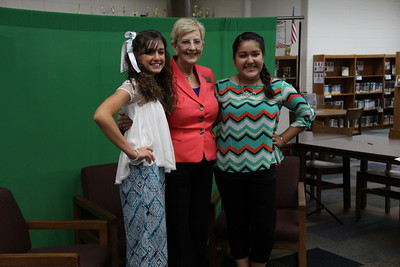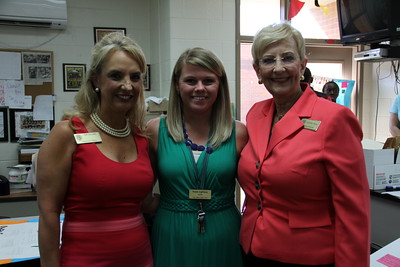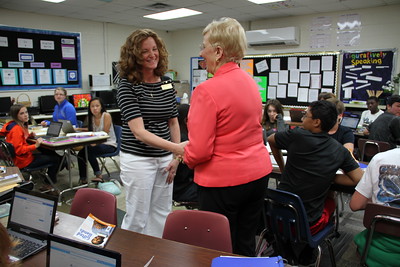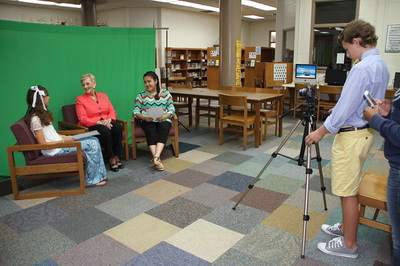|
Now that the adrenaline has settled, bags unpacked, and laundry finished (though putting it up may be more of a challenge), I can honestly reflect back on my experience at ISTE 2015. There is absolutely no question that I missed a great deal over the three days I was in Philly, but I also learned a great deal. The passion I saw in fellow educators, the ideas being discussed, projects being collaborated on, and the topics presented (okay, and the neat gadgets-let’s be a tad honest, shall we?) were overwhelming, exciting, and invigorating. But as with all things tech, you need to learn how to get to the heart of what you’re learning. Here are my takeaways.
#1: Technology is not a babysitter. Listen, good teaching has always been about building relationships with your students, learning about your students, how your students learn best, and knowing your curriculum inside and out. Technology has never, and will never, replace a good teacher. A lot of times using technology is pushed in school systems because of the amount of money it takes to gain successful technology resources (it's in the SIP, in the grant, etc). However, you need to understand why you are using tech in your classroom beyond that you are asked to do so. If you are not going to use technology to make learning more interactive, engaging, and meaningful, do not use it at all. Yes, I understand students need to learn how to type. Yes, I understand they need basic tech skills. However, if all your students do is type an essay in Google Docs to share it with you, that student is no better off than using a paper and pencil and the tool has been wasted. You have missed out on a vaulable opportunity for students to collaborate, problem-solve, and interact. Think about having students share their Docs with each other and use chat to have meaningful discussions about their work. Have students create a Google Site to use as a portfolio, showcasing essays or projects they have been working on throughout the year with reflections on how their learning has changed. Provide meaningful feedback using the comment section of Google Docs. To me, just using technology for the sake of using it is a lot like using the TV as a babysitter for your child. If you want to go beyond just using a tool, and don't know how, ask your school librarian or go to Google and search for it. Do not use it as a crutch. Best ISTE Tweets About This Subject:
Need some motivation to get creative with tech?
#2: I totally need a MakerSpace.
MakerSpaces have been on my mind for the past year (maybe even two?), but it hit me during my time in Philly that I need to stop thinking and planning and actually CREATE it. The ISTELib community was all about it, through formal sessions, informal meetings in the hall, in the ISTELib Playground, etc. It was in my face the entire time (okay, maybe, just maybe, I was searching for it...). So why a MakerSpace in the library? We are constantly bombarded with the idea that the U.S. is "behind" the rest of the world in STEM education, that our students need to be able to think critically, problem-solve and collaborate in order to succeed in the future they will inhabit. (Forget the fact that critical thinking, problem solving and collaboration are part of what schools should be designed to support in the first place. Hello, John Dewey. Possibly heard of him?) Makerspaces provide creative time and, well, space for people of all ages to build prototypes, explore questions, fail and retry, bounce ideas off one another, and build something together. Our rural school in Jesup, GA needs to prepare our students just as well as the fully-funded STEM/STEAM/Charter schools in Atlanta. We don't have the same amount of funding and grants to be able to offer extra classes in connections hall, add extra certified teachers, or purchase equipment through the school. Often our fundraising is limited by the median income of our students families. So where are students going to be able to learn to push boundaries, experiment, and be creative in pursuing their passions? Or even learn that there are other careers besides working at Rayonier, farming, or teaching? I feel the need to fill-in the gap for our students at AWMS, to help in anyway I can to help students explore their world and their learning experience. I will be looking for any money I can spare this year, along with creating a GoFundMe campaign or a DonorsChoose account to help add resources for our library. I'm also going to incorporate ideas of our students. What do they want to see change to fit their needs? Other reasons:
Best ISTE Tweets About This Subject:
#3: Involve students in their learning.
John Dewey has said, "Education is not preparation for life; Education is life itself." The idea, theory, and research which says that students learn best by doing, by being involved in their learning, by questioning, and thinking critically about the world has been around since Confucius, Aristotle, and Socrates. It's not that we don't know it's research-based, that it's best practice in education...It's that we need to actually do it. Why do our classrooms still look like straight rows, teacher-directed, and lifeless versions of the ideas of these great men? Because it's hard. Because it takes a tremendous of planning. Because we may fail. Because we have so many standards to teach. Because of TKES being a checklist. Because we have benchmarks and standardized testing scores to meet. Because if we don't prove ourselves with our test scores, we are not validated by state/federal funding or the community. Because we are scared. I'm too scared for our students, my children, to learn in a traditional school classroom, not to put this out there. We need to change the way we teach. "Fear cuts deeper than swords," a wise quote in The Game of Thrones. Bravery is doing the right thing in the face of fear. We need to be brave in our profession. Huzzah! “Keep in mind that many people have died for their beliefs; it's actually quite common. The real courage is in living and suffering for what you believe.” --Christopher Paolini in Eragon (On a side note, if you have not read Malala Yousafzai's memoir, you really need to give it some attention. I purchased it for our library if you want to check it out!) Best ISTE Tweets About This Subject:
#4: Support each other on our path to learning. We've all heard the new teacher advice, "Stay out of the teacher's lounge." It's meant to warn new teachers about gossip in the work place, being around negative people that can bring you down, and generally a place to sulk when you've had enough of that 'bad' kid. We, collectively as a profession, need to change this climate in schools. The teacher's lounge or classroom, library, conference room, or wherever teachers meet, needs to be a place of sharing, collaborating, and a sound board for trying new things. It may take work, but we need to cultivate that type of climate in our schools. If you can't in your own environment, find an uplifting lounge online through Twitter or Edmodo. Creating a personalized professional learning network online can be an invaluable resource for you as an educator. I love my PLN, a place I can go to be uplifted, get new ideas, bounce off ideas, get feedback, and find optimism when my day has been more than a tad bit rough. I am always on the side of don't complain, find a solution. Having a group at school or online that supports that in order for to keep moving forward with your students is essential. “If I don’t know how to do something, there’s probably someone in the building that does, so all I have to do is ask.”-Jessica McMahon “What is a tech coach? Supporting LEARNERS with technology and education to make meaningful connections.”-Allison K. #5: I know I said focus on learning and not the tool, but Google Cardboard is AWESOME! Sure, we’ve all heard about virtual reality, but its use in the classroom has seemed much more gimmick than actual learning tool. Google is attempting to change the conversation by eliminating two of the biggest roadblocks: cost and lack of practical uses. The cardboard glasses (yes, they really are cardboard) can be made at school with kits you purchase and personalize or ordered for about $30 a pair. Each set must be paired with a smartphone; right now Google’s apps only work with Android phones. But the real win is the content Google has created. More than 100 apps let students swim through a coral reef and play Ping-Pong, and Expeditions offers a wide variety of student field trips. In addition to breathtaking locales, the videos tackle more mundane, but useful, topics, such as examining a day in the life of a veterinarian. I'm thinking Apple needs to jump on this so my iPads can become learning opportunities like this for our SS classes (the poor redheaded step-child). #6: Google Apps for the Classroom Our school is focusing on going 1-to-1 with Google Chromebooks, or at least a class set for each room, which is essentially the same thing. With our school improvement plan this year focusing on literacy and Lexiles and our push for Chromebooks in the classroom, it made sense for me to focus on how I can help as the School Librarian on this ISTE trip. One of my favorite sessions, a hard to get ticketed session (“Ooooo, Ahhhhhh”), focused on Chrome extensions and apps to use for reading and writing. Read & Write Google struck me as extremely useful while still being semi-affordable. It ends up being about $10 per student if purchased individually, but it makes more sense to purchase as a district, which ends up being about $800 per school instead of thousands of dollars per school. Susan Hardin put together an amazing list of resources for us on what we can use to better assist our students in their learning. I also learned about Hangouts on Air, which is a live stream of a Google Hangout, which can be played through your YouTube channel, an embedded link, and is recorded for later. My master’s and specialist classes have all used Google Hangouts, but maybe I’ve been extremely out of it in not knowing about it being LIVE as well. The possibilities for this in our library and for our school are endless, from broadcasting our student news for the school and the community, book talks during lunch, to recording live events from school (like Title 1 meetings or band concerts). I’m extremely excited about trying this out in the library!! #7: The Learning Never Stops I am a professional student by nature (graduations have come and gone...I keep telling my husband, "One more year of school-I promise!" Hah! Late nights on Twitter for #Educhat #Tlchat instead of going to bed...), but I do think it's one of the most important takeaways from a conference like this. It's easy to walk away thinking about all the cool gadgets or the extremely engaging stuffed animal monster project a school in somewhere did with their students. It's also easy to just stuff those resources or tweets away, after you write this neat little reflection of course, and get back to the daily grind without absorbing and taking in what you learned. It's our responsibility as educators to stay on the forefront of research in our profession, share that with others, and consistently encourage our colleagues to do the same. I'm excited to announce that my principal is allowing me to conduct professional learning opportunities for our staff this year once a month to share ideas, tools, pedagogy, etc. so our learning won't end! This year is a new beginning, as always, and I'm looking forward to sharing what I've learned, and what teachers have learned.
So what did I learn? I know very little in the midst of others, I need to be more courageous, and some hard truths.
As many of you know, I was able to attend ISTE 2015 in Philadelphia this year (woo hoo!) so that I can gather an enormous amount of ideas and tools for our teachers and students here at AWMS. I am working on putting together my top 10 take aways from ISTE, but until then, here is my #1! PADCASTER!
I am now a Symbaloo certified teacher (well, librarian...)! It took a bit, but I am really excited about learning this new tool for learning and how it can be applied to the classroom and the library. Our teachers are going to love it. Feel free to ask questions about it and I will definitely be doing a professional development session during the beginning of school on this nifty website. Thanks Symbaloo for all the neat ideas!
With how busy we were at the end of the year, I was never able to post the amazing opportunity our news crew had on teacher appreciation day (May 5th).
Our ADUB News Crew not only got to meet the First Lady of Georgia, but were allowed (and encouraged) to interview her! Stephanie, a 7th grader, and Chloe, a sixth grader, handled themselves with professionalism, grace, and courage as they interviewed Mrs. Deal. Our entire news crew was able to participate in the interview, take pictures, and film, and were extremely professional and thankful of the chance to be 'real' reporters. I am so proud of these amazing students in challenging themselves and experiencing something outside of their comfort zones. I see great things happening with this crew, now and in the future! The last week of school, we were able to celebrate with all students who reached their AR goals for three out of the four nine weeks. This year, I decided to change things up a bit. Thanks to Graceland Bounce in Hinesville, we got an amazing discount on three inflatable stations for the reading stars. The first was a 25 ft. high water slide with a pool. The second was an all-sports activity center where students could bounce while playing basketball, football, and of course some "boxing." The third was my favorite-an inflatable pool with HAMSTER BALLS! How fun! Students were able to get snacks, drinks, and listen to music while chilling out on the field. To end our afternoon, we had a good old-fashioned water balloon fight between the grade levels. I may have been the coach for the sixth grade team, but I think they won...I'm not biased in the least. The students had a blast. The teachers volunteering had a blast. I had a blast. Next year will definitely have to see a second annual end-of-the-year water day! All fun aside, I am seriously proud of our students. Not only did over 200 students reach their goal for the year, but that was an increase of over 50 students from the previous year. STAR reading levels increased as well. Our teachers worked hard proving support in the classroom, our library provided support and encouragement outside the classroom, and we had a very supportive administration. Next year, I hope to see more parent involvement! |
Mrs. BongiornoReading enthusiast and technology innovator Archives
June 2016
|






